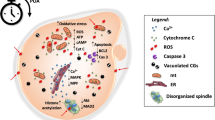Abstract
This study evaluated the effect of ovum aging on the in vitro fertilizability of mouse ova. Over 1347 ova were evaluated. Serial trypsin digestion of in vitro and in vivo aged ova revealed an increase in zona digestion time (0.25% trypsin) beginning at 40 hr, which increased over a 40-hr period and resulted in the unfertilized zona becoming as “hard” as the fertilized embryo zona. In vitro fertilizability showed a rapid decrease as zona hardening occurred with loss of cortical granules as assessed by electron microscopy. These data suggest that the window of fertilizability is “closed” by a spontaneous zona reaction occurring at about 55 hr post-human chorionic gonadotropin with loss of cortical granules and zona hardening as manifested by increasing zona digestion time with 0.25% trypsin.
Similar content being viewed by others
References
Wolf DP, Inoue M: Sperm concentration dependency in the fertilization and zonae sperm binding properties of mouse eggs inseminatedin vitro. Exp Zool 1975;196:27–37
Gulyas BJ: Cortical granules of mammalian eggs. Int Rev Cytol 1980;63:357–392
Wolf DP: The mammalian egg's block to polyspermy.In Fertilization and Embryonic Developmentin vitro, L Mastrioianni, JD Biggers (eds) New York, Raven Press, 1981, pp 183–197
Wassarman PM: The biology and chemistry of fertilization. Science 1987;235:553–560
Chang MC, Hunt DM: Effects of proteolytic enzymes on the zona pellucida of fertilized and unfertilized mammalian eggs. Exp Cell Res 1956;11:497–499
Gould K, Zaneveld LJD, Srivastava PN, Williams WL: Biochemical changes in the zona pellucida of rabbit ova induced by fertilization and sperm enzymes. Proc Soc Exp Biol Med 1971;136:6–10
Inoue M, Wolf DP: Fertilization-associated changes in the murine zona pellucida: A time sequence study. Biol Reprod 1975;13:546–551
Adams CE, Chang MC: The effect of delayed mating on fertilization in the rabbit. J Exp Zool 1962;151:155–158
Dziuk PJ, Polge C: Fertility in swine after induced ovulation. J Reprod Fertil 1962;4:207
Juetten J, Bavister BD: Effects of egg aging onin vitro fertilization and first cleavage division in the hamster. Gamete Res 1983;8:219–230
Marston JH, Chang MC: The fertilizable life of ova and their morphology following delayed insemination in mature and immature mice. J Exp Zool 1964;155:237–251
Guerrero R, Rojas OI: Spontaneous abortion and aging of human ova and spermatozoa. N Engl J Med 1975;293:573–575
Critser ES, First NL: Use of a fluroescent stain for visualization of nuclear material in living oocytes and embryos. Stain Technol 1986;61:1–5
Longo FJ: Aging of mouse eggsin vivo andin vitro. Gamete Res 1980;3:379–393
Watson ML: Staining of tissue sections for electron microscopy with heavy metals. J Biophys Biochem Cytol 1958;4:475–478
Reynolds ES: The use of lead citrate at high pH as an electron opaque stain in electron microscopy. J Cell Biol 1963;17:208–212
Sato K: Polyspermy-preventing mechanisms in mouse eggs fertilizedin vitro. J Exp Zool 1979;210:353–359
Wasserman PM: The zona pellucida: A coat of many colors. BioEssays 1987;6:161–166
Gulyas BJ, Schmell ED: Ovoperoxidase activity in ionophore treated mouse eggs. I. Electron microscopic localization. Gamete Res 1980;3:267
Schmell ED, Gulyas BJ: Ovoperoxidase activity in ionophore treated mouse eggs. II. Evidence for the enzyme's role in hardening the zona pellucida. Gamete Res 1980;3:279
Wolf DP, Hamada M: Age dependent losses in penetrability of mouse eggs. J Reprod Fertil 1976;48:213–214
Miller MA, Masui Y: Changes in the sulfhydryl level in the sperm nucleus during sperm-oocyte interaction. Gamete Res 1982;5:167–179
Flechon JE, Huneau D, Solari A, Thibault C: Reaction corticale et blocage dela polyspermie dans l'oeuf de lapine. Ann Biol Anim Biochim Biophys 1975;15:9–15
Longo FJ: Ultrastructural changes in rabbit eggs agedin vivo. Biol Reprod 1974;11:22–39
Overstreet JW, Bedford JM: Comparison of the penetrability of the egg vestments in follicular oocytes, unfertilized and fertilized ova of the rabbit. Dev Biol 1974;41:185–192
Kaleta E: Sperm penetrationin vitro into ovarian and tubal oocytes from mice of the inbred KE and C57 strains. Gamete Res 1979;2:99–104
Wabik-Sliz B: Number of cortical granules in mouse oocytes from inbred strains differing in efficiency of fertilization. Biol Reprod 1979;21:89–97
Okada A, Yanagimachi R, Yanagimachi H: Development of a cortical granule-free area of cortex and the perivitelline space in the hamster oocyte during maturation and following ovulation. J Submicrosc Cytol 1986;18:233–247
Nicosia SV, Inoue M, Wolf DP: An ultrastructural study of cortical granule dehiscence in mouse eggs inseminatedin vitro. Fertil Steril 1975;26:198–199
Author information
Authors and Affiliations
Rights and permissions
About this article
Cite this article
Dodson, M.G., Minhas, B.S., Curtis, S.K. et al. Spontaneous zona reaction in the mouse as a limiting factor for the time in which an oocyte May be fertilized. J Assist Reprod Genet 6, 101–106 (1989). https://doi.org/10.1007/BF01130735
Received:
Accepted:
Issue Date:
DOI: https://doi.org/10.1007/BF01130735




